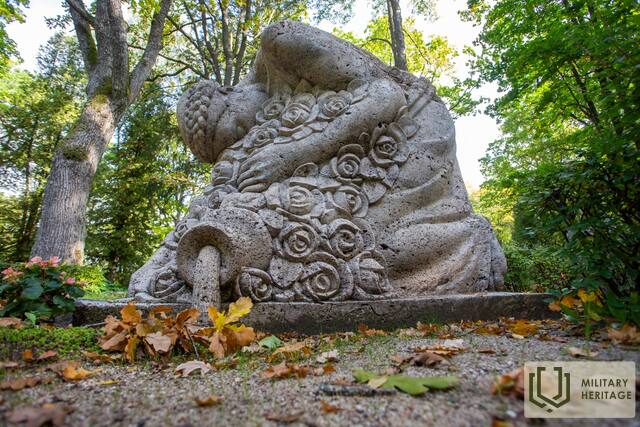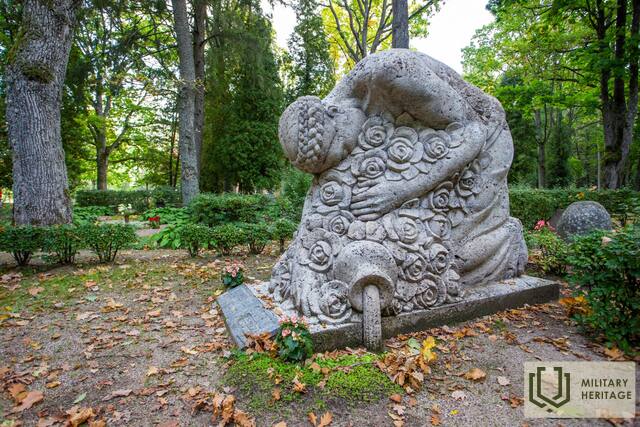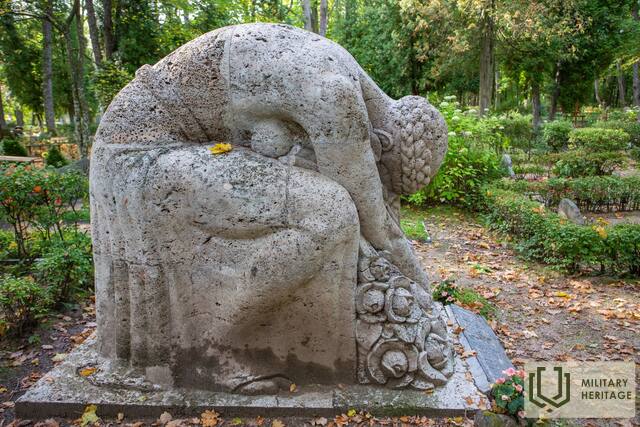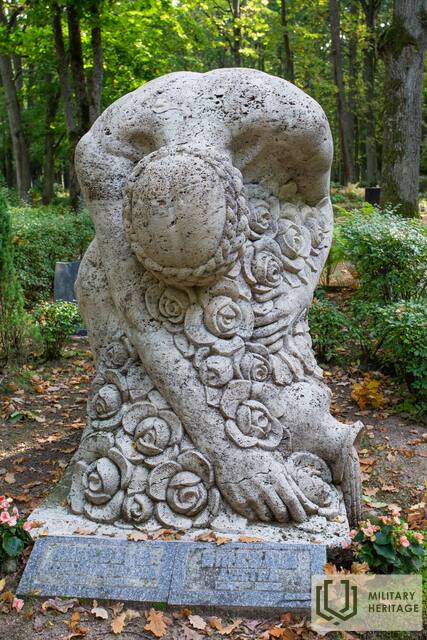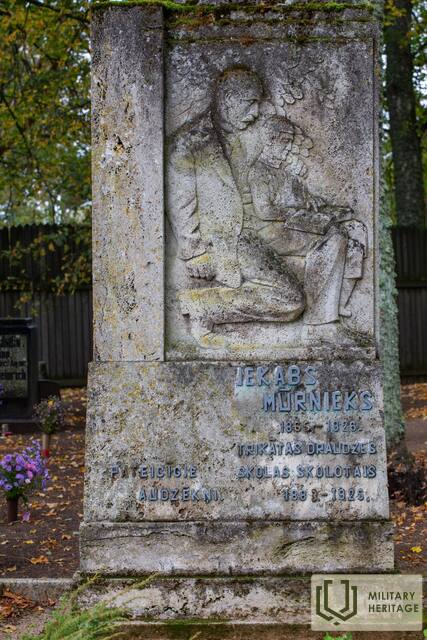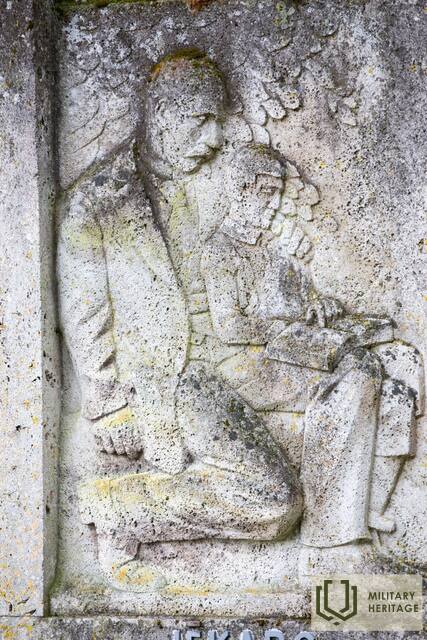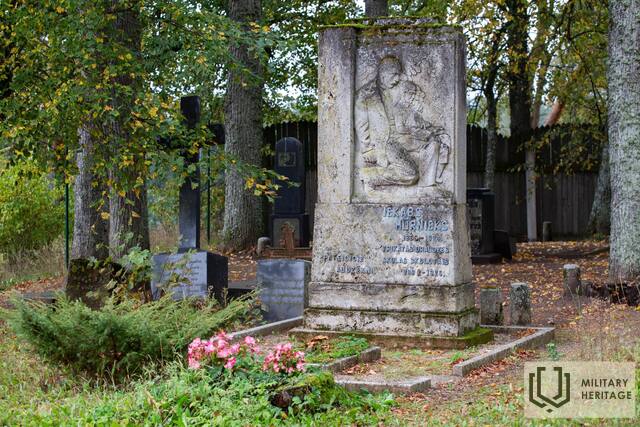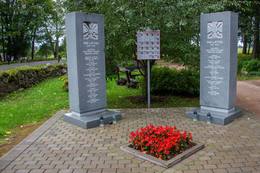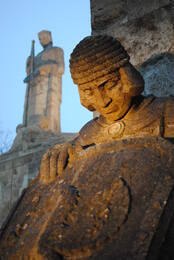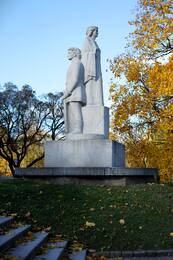Apie mažiau žinomus latvių skulptoriaus Kārlio Zāles kūrinius senosiose Dīvalos ir Trikātos kapinėse
Vienas iš mažai žinomų skulptoriaus Kārlio Zālės (1888–1942) darbų yra travertino skulptūra „Nukritusios rožės“, sukurta 1939–1940 m. ir siejama su Brolių kapinių ansamblio sukūrimu.
Kuriant Brolių kapinių ansamblį, buvo svarstomas pasiūlymas centrinėje kapinių dalyje įrengti baseiną. Skulptorius ruošėsi tokiam sprendimui ir iškirto šias dvi panašias skulptūras, ketindamas jas pastatyti prie įėjimo į baseiną. Tačiau baseino įrengimo idėja buvo atmesta ir vietoj jos buvo įrengta veja. Dėl to „Nukritusios rožės“ nerado savo vietos Brolių kapinėse ir buvo įrengtos atskirai, prie privačių asmenų kapų: viena Rygos I Mežos kapinėse, kita – Valmieros Dīvālių kapinėse. Abi skulptūros vaizduoja parklupusią moterį, kuri gedi išėjusiųjų. Nukritusios rožės ir apvirtęs vandens indas pasakoja apie nutrūkusį gyvenimą. Skulptūros pagamintos iš travertino ir įrengtos ant žemo pagrindo.
Skulptūra nuo 1950 metų yra Valmieros Dīvalo kapinėse.
Kitas mažiau žinomas Kārlio Zālės kūrinys – liaudies mokytojo Jėkabo Mūrnieka (1865–1926) paminklas. Jis stovi senosiose Trikatos kapinėse. „Kilnus darbas veda į amžinybę“ – toks mokytojo šūkis užrašytas paminklo gale.
Gana sudėtinga architektūrinė kompozicija apima didelį bareljefą, kuris, matyt, atsižvelgiant į užsakovų pageidavimus, vaizduoja mokytoją, sėdintį po mokyklos liepomis su atversta knyga, o prie jo glaustosi mažas berniukas. Šis bareljefas yra bene vienintelis Kārlio Zāleso kūrinys, pasižymintis išskirtiniu įvaizdžiu. Neįprasta jo rašysenai, vaizdų detalumas yra įspūdingas.
Jēkabas Mūrnieksas Trikātos parapinėje mokykloje nepertraukiamai dirbo 42 metus, o per jo laiką parapinėje mokykloje išugdė daug žinomų Latvijos valstybės, kariuomenės, visuomenės ir profesionalų darbuotojų – karo ministrą generolą Jāni Balodį, generolus Kārlį Goppersą ir Robertą Dambītes, Seimo narį, pulkininką Eduardą Laimiņšą ir daug kitų pulkininkų.
1928 m. dėkingi studentai Trikātos kapinėse pastatė paminklą Jēkabui Mūrniekui, kurį sukūrė skulptorius Kārlis Zāles.
http://trikatasvesture.beverina.lv/index.php/pieminekli
https://www.vestnesis.lv/ta/id/59018
http://trikatasvesture.beverina.lv/index.php/sakums/arhivs-2020
Susijusios temos
Susijusios vietos
Lāčplėsio karinio ordino generolų ir riterių atminimo vietos Trikātos valsčiuje
Atminimo stela yra šalia Trikatos kapinių koplyčios.
Trikātos kapinėse saugomas trijų iškilių Latvijos generolų – Roberto Dambīčio, Kārlio Gopperso ir Jānio Balodžio – atminimas. Trikātos kapinėse palaidotas ir visų šių generolų mokytojas Jēkabs Mūrnieks, kuriam 1928 metais palaidojimo vietoje buvo pastatytas paminklas iš travertino, sukurtas pagal Kārlio Zāle pavyzdį.
Lačplėsio karinio ordino generolai ir riteriai kasmet pagerbiami fakelų procesijomis į Trikatos kapines, kur yra dvi atminimo stelos, kuriose iškalti 17 su Trikatos parapija susijusių Lačplėsio karinio ordino riterių vardai.
Stela buvo atidengta 2018 m. lapkričio 11 d.
Vaizdo įrašas apie Lāčplės karo ordiną ir ordinų rinkinį , priklausiusį generolui Jāniui Balodiui.
Karinio paveldo paminklai Dīvalinios kapinėse Valmieroje
Įsikūręs Valmieros Dīvalas (Jānis) kapinėse Valmieroje.
Matomas skulptorės Martos Lange sukurtas ir 1937 m. rugsėjo 26 d. atidengtas iš Allažio travertino pagamintas paminklas.
Stulpo formos paminklą vainikuoja nuožulnus altorius, ant kurio stovi ąžuolo lapų vainikas ir iš travertino išdrožtas šalmas.
Palaidota apie 80 karių, žuvusių Latvijos Nepriklausomybės kare, taip pat tų, kurie mirė nuo sužalojimų ir ligų.
Netoliese yra vienas iš mažiau žinomų Kārlio Zāleso darbų – paminklas „Nukritusios rožės“, siejamas su Brolių kapinių ansamblio sukūrimu.
Netoliese yra ir komunistinio teroro aukų memorialas – akmuo su užrašu: „1941 m. komunistinio režimo nužudytiesiems“ ir balti kryžiai.
Brolių kapinės Rygoje
Rygos brolių kapinės yra šiauriniame Rygos rajone. Kapinės užima 9 ha plotą ir yra iškiliausias bei reikšmingiausias memorialinis ansamblis Latvijoje, skirtas žuvusiems Latvijos kariams. Čia palaidota apie 3000 karių. Brolių kapinės buvo įkurtos Pirmojo pasaulinio karo metu, palaidojus pirmuosius tris Latvijos šaulius, žuvusius Tyrelio purve mūšyje prieš vokiečių armiją. Vėliau Brolių kapinėse taip pat buvo palaidoti Latvijos kariai, žuvę kituose mūšiuose ir karuose. Memorialas sukurtas pagal skulptoriaus Kārlio Zālės projektą ir yra pirmasis memorialinis ansamblis Europoje, turintis tokią kraštovaizdžio, architektūros ir skulptūrinę vertę. Jame naudojami Latvijos kraštovaizdžiui būdingi elementai, tradicinės sodybos, Latvijos folkloras ir istorija, kurie giria karių savybes ir pasakoja apie kario kelią. Memorialas buvo atidengtas 1936 m. ir jį sudaro trys dalys: „Minties kelias“ – 250 m ilgio alėja, „Didvyrių terasa“ su Šventosios liepsnos aukuru ir Šventosios ąžuolyno ansambliu bei laidojimo vieta su Latvijos siena ir motinos su žuvusiais sūnumis memorialu.
Duobelės išlaisvinimo paminklas
Duobelės išlaisvinimo paminklas yra Duobelės mieste, maždaug 250 metrų į vakarus nuo Bērzės tilto, priešais Duobelės pilies griuvėsius.
Duobelės išlaisvinimo paminklas skirtas Pirmajame pasauliniame kare ir Latvijos laisvės kovoje žuvusiems kariams. Skulptorius Kārlis Zemdega sukūrė Duobelės išlaisvinimo paminklą kaip dviejų figūrų kompoziciją, kurioje senovės Latvijos karys yra tautos stiprybės simbolis, o tautodailė – Tėvynės atvaizdas – išreiškia dvasinio aiškumo idealą.
Idėja pastatyti paminklą Duobelyje buvo iškelta 1924 m., tačiau paminklo statybos darbus K. Zemdega pradėjo tik po dešimties metų, 1934 m. Paminklas buvo iškaltas iš 44 tonas sveriančio suomiško granito luito, o kartu su pagrindu paminklas pasiekė 4,5 m aukštį. Iškilmingas paminklo atidarymas įvyko 1940 m. birželio 9 d. dabartinių sovietų karių kapinių paminklo vietoje, Brīvības gatvėje, kur iki 1950 m. stovėjo Duobelės išlaisvinimo paminklas, kol jis buvo susprogdintas sovietų valdžios įsakymu.
Prasidėjus nacionalinio atgimimo epochai ir dėka K. Zemdegos sukurto paminklo restauravimo iniciatorių – Latvijos kultūros fondo Dobelės skyriaus – atkaklių veiksmų, 1988 m. liepos 21 d. Latvijos komunistų partijos Dobelės rajono komiteto biuras ir Dobelės rajono Liaudies deputatų tarybos vykdomasis komitetas priėmė sprendimą paremti Dobelės darbo kolektyvo ir gyventojų iniciatyvą restauruoti Stalino kulto metu sunaikintą paminklą. Tuo pačiu metu buvo įsteigtas Paminklų restauravimo fondas, į kurį įmonių, organizacijų ir privačių asmenų aukos buvo naudojamos K. Zemdegos paminklui aikštėje priešais Dobelės pilies griuvėsius restauruoti ir įrengti. Ši vieta buvo parinkta atsižvelgiant į gyventojų apklausos rezultatus. Paminklas buvo restauruotas ir įrengtas 1996 m. Dobelės gyventojų aukomis. Paminklas buvo pagamintas iš granito akmens, atvežto iš Zaporožės, Ukrainos, o jį pagal skulptoriaus Intos Bergos projektą nukalė akmenininkas Liberijus Pelņa.
Laisvės paminklas Rygoje
Laisvės paminklas buvo vienas iš centrinių simbolinių Atgimimo įvykių taškų. 1987 m. birželio 14 d. žmogaus teisių grupė „Helsinki-86“ surengė nesankcionuotą viešą gėlių padėjimo ceremoniją prie Laisvės paminklo. Po dviejų mėnesių, rugpjūčio 23 d., „Helsinki-86“ paragino surengti mitingą prie Laisvės paminklo, minint 48-ąsias Hitlerio ir Stalino pakto, pasirašyto 1939 m. rugpjūčio 23 d., metines. Šio mitingo metu sovietų policija sumušė ir suėmė demonstrantus. Vėlesniais metais gėlių padėjimo ceremonijos prie Laisvės paminklo tapo visų didesnių demonstracijų ir kitų masinių renginių dalimi.
Įsikūręs Rygos centre, Laisvės aikštėje.
Laisvės paminklas yra vienas iškiliausių Latvijos istorijos, architektūros ir meno paminklų. Pastatytas pagal Kārlio Zālės projektą visuomenės aukomis. Jis buvo atidengtas 1935 m. kaip Latvijos žmonių laisvės ir meilės tėvynei simbolis. Kartu su Rygos brolių kapinių ansambliu jis yra vienas vertingiausių monumentaliosios architektūros ir skulptūros pavyzdžių.
Laisvės paminklas išreiškia Latvijos kultūros etines ir estetines vertybes. Simboliai atspindi filosofinę laisvės esmę ir Latvijos tautos istorines idėjas apie kovos už nepriklausomybę etapus. Jie nurodo į fizinės ir dvasinės stiprybės įsikūnijimą. Herojiška kalba pasakoja apie Latvijos žmones kaip savarankiškus, aktyvius istorijos kūrėjus ir savo likimo lėmėjus.
Jo vietoje iš pradžių stovėjo paminklas Rusijos carui Petrui I. Pirmojo pasaulinio karo metu jis buvo išardytas ir laivu nugabentas į Petrogradą. Laivą torpedavo vokiečių povandeninis laivas, ir jis nuskendo prie Estijos Vormsi salos. Sovietų okupacinis režimas kelis kartus planavo nugriauti Laisvės paminklą, tačiau to neįvyko.
Šiandien galite pamatyti vieną iš Latvijos simbolių ir stebėti kariuomenės garbės sargybos tradicijas.
Ant kanalo kranto, šalia Laisvės paminklo, sukurtas taktilinis Laisvės paminklas. Šią ypatingą bronzinę miniatiūrą 1:50 masteliu sukūrė skulptorius Ivaras Miķelsonsas.




